The trouble is that most people simply don’t know that a sugar beet industry exists here in the UK. Six out of ten adults were unaware that sugar is grown here in the UK. There’s a common misconception that all the sugar we eat and use in cooking comes from sugar cane grown abroad.
It’s almost impossible to tell the difference in taste between sugar derived from cane and sugar derived from beet, so this begs the question: “why should we care about where the sugar we buy comes from?”
In fact, we should care, because the sugar industry supports up to 9,500 jobs within the UK economy, from farmers to road hauliers and processors. It’s an unusual commodity too, because not only does the sugar beet need to be processed before it’s suitable for consumption, but also there’s only one company in the UK which can process sugar beet: British Sugar plc.
For the growers, only having one possible buyer of their product is a peculiar position to be in. The majority of growers will grow other crops alongside their sugar beet, with sugar being an integral part of the farms multi-year crop rotation.
Sugar beet growers, therefore, must ensure they get the best price possible from British Sugar plc as they are the only buyer, and the NFU’s Sugar team is the crucial connecting point because it negotiates with British Sugar plc on behalf of all beet growers.
About the industry
Sugar beet is the UK-grown crop that sucrose (what you see in your sugar bowl) is extracted from. It provides just over half of all the sugar we consume. Sugar beet is a large pale brown root crop (see picture below), similar to parsnip and has a sugar content of around 16% when it is harvested.
Sugar beet is primarily grown in the East of England. From sowing to harvest, growing sugar beet can take up to 12 months to be ready, with most sown from late-February to late- March. However, because most farms which produce sugar beet also grow a range of other crops like cereals, potatoes and oil seed rape, the preparations often begin once the previous crop has been removed the season before. Managing the soil is important to sugar beet growers, and some of them will plant a cover crop such as spring barley along with the sugar beet, and this helps protect the soil from wind and water erosion as the beet germinates.
Over the coming months, the crop will grow from a tiny seed to a big plant with a large root, which is where the sugar is stored. In order to maximise the root growth, weeds such as poppy and cleaver need to be kept under control to prevent the tiny sugar beet being smothered.
The beet is harvested in the Autumn and Winter, with the root lifted and collected by a machine which removes the leaves and they are left in the field to return organic matter to the soil, and some are also eaten by wildlife such as the Pink-Footed Geese.Sugar beet factories usually begin processing sugar during October and finish by the following March. During this time, the farm harvests the sugar beet and briefly places it into a pile known as a clamp where the beet is accumulated before being loaded onto lorries and taken to the factory.
Once in the factory, the sugar is extracted by special machines and the by-products are separated so they can be sold into a multitude of industries including animal feed and cosmetics. The extracted sugar is then either packaged and sent to supermarkets or sent in bulk to food manufacturers. Meanwhile on farm the whole process begins again with crops such as spring barley being sown into the recently harvested field.One of the reasons farmers grow sugar beet is because it is a good rotation crop. It’s important to vary the crops grown on a field each year to prevent the build up of pests and diseases.
To do this, farmers will only grow a particular crop on the same patch of land once every four to five years to help protect the soil. A typical rotation might include wheat, oilseed rape, sugar beet or barley, with sugar beet being the ‘break crop’. This does exactly what it sounds like – sugar beet will give the field a break, or a rest, from the pests and weeds that affect the other crops.
Modern harvesters remove as much soil as they can; no farmer wants to see more soil removed than is necessary. About 5% of the total harvest weight is soil and stones which get stuck to the beet. Once removed from the beet these are recycled. According to British Sugar this is one of the lowest percentages in Europe.
When harvesting, a machine removes the leaves from the sugar beet. They then get chopped up and left in the field to return important organic material to the land ahead of the next crop. As it decomposes it helps improve the soil structure and it returns nutrients to the soil, as well as providing food for insects and birds. In more exposed areas, growers also plant another crop alongside sugar beet to help bind and protect the soil whilst the sugar beet gets established.
Medical and scientific communities agree that sugar is part of a healthy, balanced diet. No single food or drink contains all the essential nutrients your body needs, so it is important to eat a balanced diet.
The government recommends that no more than 5% of your daily calorie intake should come from ‘free’ sugars – these are the sugars added to food and drink, like cakes and biscuits. Sugars also occur naturally in foods such as fruit, veg and milk but the NHS says it isn’t necessary to cut down on these types of sugars.
However, sugar is not just used to sweeten food and drink. It has a number of useful roles as a natural preservative and to improve the texture of food.
Sugar and the UK economy
The British beet sugar industry grows, processes and delivers high quality sugar to around 50% of the UK market, and exports across the world. It is the lowest cost sugar producer in the world.
The industry supports up to 9,500 British jobs. Jobs are created in the manufacturing plants and on farms. Suppliers to the factories also create more jobs as the demand for services increases in line with sugar production and manufacturing processes.
In addition, the British homegrown sugar supply chain involves around 7,000 different businesses making it one of the largest customers for many goods and services in the East of England.
Sugar and the environment
Like carrots and parsnips, sugar beet is a root crop which grows down into the soil and it requires big machinery to harvest it. Farmers take great care during this process to ensure that they lose as little as possible in the harvesting process because for them, protecting the soil is crucial. Healthy soil is a farmers most important asset.
Modern harvesters remove as much soil as they can; no farmer wants to see more soil removed than is necessary. About 5% of the total harvest weight is soil and stones which get stuck to the beet. Once removed from the beet these are recycled. According to British Sugar this is one of the lowest percentages in Europe.
When harvesting, a machine removes the leaves from the sugar beet. They then get chopped up and left in the field to return important organic material to the land ahead of the next crop. As it decomposes it helps improve the soil structure and it returns nutrients to the soil, as well as providing food for insects and birds.
In more exposed areas, growers also plant another crop alongside sugar beet to help bind and protect the soil whilst the sugar beet gets established.
Sugar beet has a large and deep root which makes it very resilient and tolerant of dry weather. Sugar beet is a water efficient crop and does not need any artificial irrigation; during the drought in 2018, some sugar beet looked to be wilting badly but it survived and went on to grow well once the weather improved.
Just like all crops, a number of pests and diseases can affect sugar beet and these need to be managed. Aphids, a small insect commonly known as greenfly spread the most common disease called virus yellows. There is currently no cure for this disease so the only way to control it is to limit the ability of aphids to spread them.
Aphid numbers can multiply very quickly so, without alternative solutions at present, plant protection products are necessary to control them. Without doing this, crop yields would be severely affected and it could make it too difficult to grow sugar beet here in the UK, meaning we would have to import sugar from other countries which use plant protection products banned in the UK.
Sugar beet presents a number of benefits to wildlife. In particular, the open ground between the plants is perfect for ground nesting birds like the endangered stone curlew in some areas. The leaves of harvested sugar beet are also eaten by pink-footed geese in Norfolk, providing them with an energy rich source of food for their migration.
Wildlife flourish on sugar beet farms and many growers are involved in schemes to benefit and promote wildlife.
Sugar beet is grown mainly in East Anglia, as well as the East Midlands and North East. This is because it is some of the most productive land in the country, with good climatic conditions for growing sugar beet. The sugar growing areas are concentrated around the four British Sugar plc factories, which are in the East of England - Lincolnshire, Norfolk, Suffolk.
Sugar beet farmers send their crop to one of four factories run by British Sugar plc, which means that the home-grown sugar sector has some of the lowest food miles in the UK.
The average beet travels just 28 miles from its farm to the sugar factory, making it an incredibly short journey. So when you’re buying British sugar you can do so knowing that it’s had a low impact on the environment.
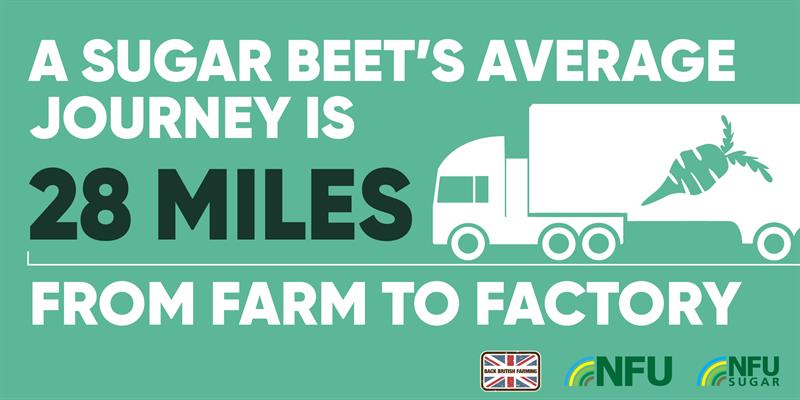
Sugar beet has an important role to play in tackling climate change. In growing the beet, precision technology and data has allowed more target application of fertilizers, and more efficient drilling and harvesting machinery all reduce the inputs required to grow the crop.
Sugar beet is also an energy dense crop, which is used to make biofuels like bioethanol which can be blended with petrol to reduce the amount of fossil fuel in every litre by up to 5%.
Sugar beet can also be used to produce biogas and soil conditioner via anaerobic digestion, all of which contributes to the green economy.
How can I support British sugar beet growers?

The sugar industry in Britain grows, processes and delivers high quality sugar to around 50% of the UK market, and exports across the world. It is the lowest cost sugar producer in the world.
Buy homegrown sugar for your table under the Silver Spoon brand and show you want to see the interests of Britain’s food industry taken into account once we leave the EU. Take a look at our Buying Guide to find out which retailers are backing British sugar.
So how does this bulky root crop transform into the sugar you use at home? Here's our quick guide:
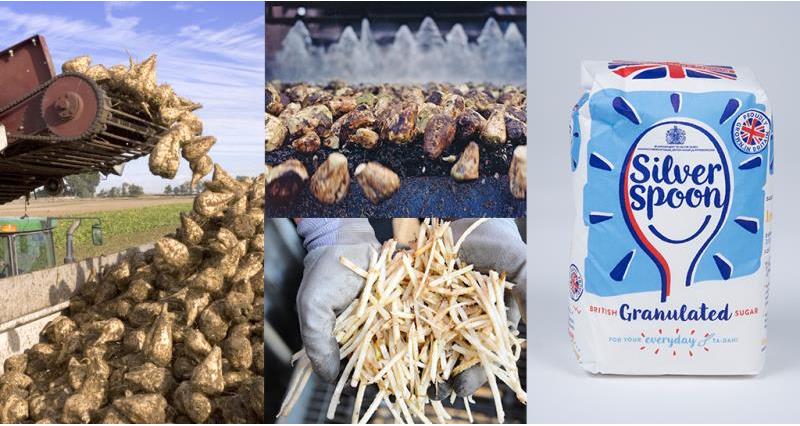
- Sugar beet harvesting takes place from early autumn through to spring. Once harvested, the crop travels an average of 28 miles to one of the four British Sugar plc factories in Bury St Edmunds, Cantley, Newark or Wissington.
- When it arrives at the factory, the sugar beet is washed in preparation for processing.
- The sugar beet is sliced into thin strips called cossettes. These thin strips are mixed with hot water to extract the sugar and a lime solution is added to the raw juice to remove any impurities.
- The syrup is filtered, heated and seeded with tiny sugar crystals, which grow into the required size. The sugar crystals are then washed, dried and cooled.
- Sugar is delivered to customers in its various formats. Most customers buy granulated sugar, but caster, icing, brown and liquid sugars are also produced.
A timeline from seed to sugar
March - April: drilling
This is when the sugar beet is planted.
May - June: crop nutrition
This is when the crop receives the additional nutrients that it needs such as Nitrogen, Potassium, sodium, magnesium and sulphur. These vary depending on the individual crop requirements.
September - March: harvest
This is when the beet is lifted (harvested) from the ground
Meet a farmer who grows sugar beet
Sugar beet grower Simon Smith farms 7,500 acres in Cambridgeshire, growing 3,000 acres of sugar beet each year.
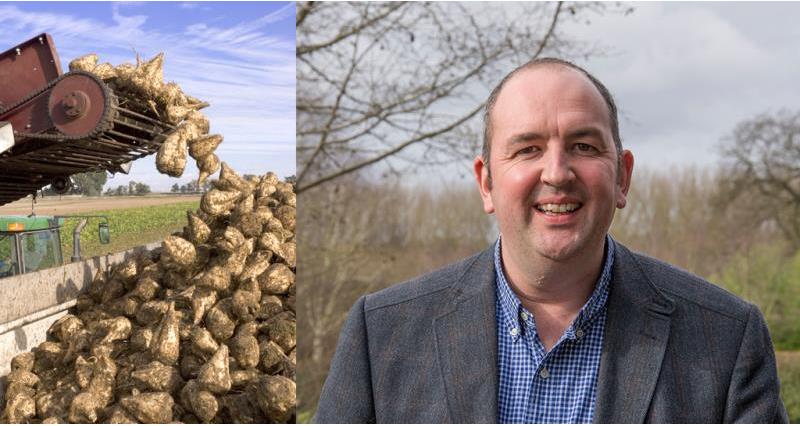
"I farm 7,500 acres in Cambridgeshire and for as long as I can remember, sugar beet has been a mainstay of the family business. As well as growing 3,000 acres of sugar beet each year, we also harvest and haul our own beet 24 miles to the British Sugar plc factory at Bury St Edmunds.
"The fact that the sugar beet industry has a monopoly processor in the form of British Sugar plc makes the NFU Sugar team and board all the more important to ensure we get a fair price for the product we grow. It also gives me, as a grower, the opportunity to work more closely with the processor than I would with my other crops.
"Growers within the British sugar beet industry have an optimistic outlook for the future, especially with yields improving year-on-year. As we move towards Brexit, it’s very important that the public supports UK produce, and this includes buying sugar made from sugar beet."
Sources: British Sugar
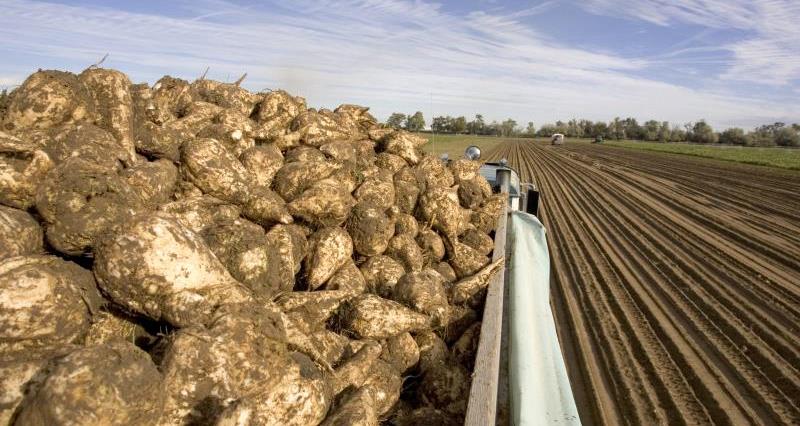
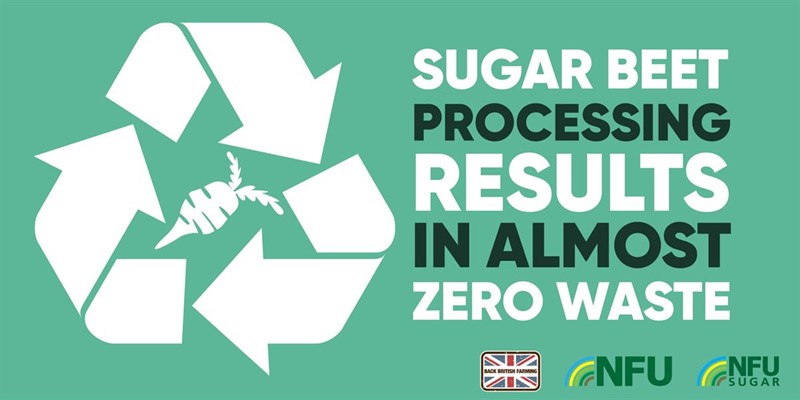 The sugar-making process results in virtually zero waste.
The sugar-making process results in virtually zero waste.